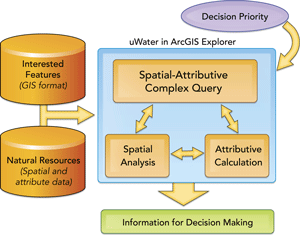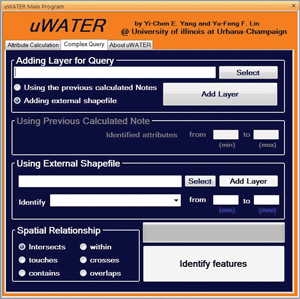ArcUser Online
Making the Results of Analysis Accessible
ArcGIS Explorer plug-in aids natural resources management
By Yi-Chen E. Yang and Yu-Feng F. Lin, University of Illinois, Urbana-Champaign
This article as a PDF.
Editor's note: A free plug-in for ArcGIS Explorer provides an accessible GIS-based decision support toolkit developed by the authors that encourages community participation.
Environmental resources management is a critical issue. Population growth means that more resources are required to sustain society and the natural environment. Yet data from the complex modeling studies that are frequently employed to quantify environmental trends are commonly either inaccessible or poorly understood by the decision makers who develop management policies and guidelines for natural resources management.
GIS is a powerful tool for evaluation and analysis of natural resources management problems. A GIS-based decision support system (DSS) can allow nontechnical individuals to visualize data and facilitate informed participation in decision-making processes. The combination of community participation and GIS-based DSS can bridge the gap between technical modeling results and social considerations for sustainable resource management.
The WebGIS Analysis Toolkit for Extensive Resources (uWATER), described in this article, is a plug-in for ArcGIS Explorer. uWATER is based on ArcGIS Explorer (build 1200) and is compatible with the more recent build 1500 of ArcGIS Explorer. It was developed using ArcGIS Explorer software development kit (SDK) with Microsoft Visual Basic 2008. The system requirements for uWATER are the same as those for ArcGIS Explorer.
In the spirit of "GIS for Everyone," this ArcGIS Explorer Web GIS application gives decision and policy makers access to technical modeling results using customized interfaces and functions provided by developers. Analysis functions such as tabular attribute calculation and spatial and attribute queries allow decision makers to systematically examine natural resource availability and the impacts of development. The input data, supplied in shapefile format, required by uWATER includes data depicting features that could have an impact on natural resources (e.g., groundwater drawdown or population distribution) and data on natural resources that could be impacted (e.g., fish habitats or river flow rates).
Interface and Methodology
Installation of uWATER is simple. It does not require installing a conventional executable file (e.g., .exe or .dll) on the destination computer. Instead, uWATER uses an ArcGIS Explorer application configuration file (.ncfg) that installs automatically on any computer on which ArcGIS Explorer is properly installed. Obtain uWATER by downloading the uWATER toolkit from isws.illinois.edu/gws/sware/uwater/.
Double-clicking the uWATER1.0.ncfg icon opens ArcGIS Explorer and adds a customized tab, uWATER1.0, to the default ArcGIS Explorer interface. The uWATER1.0 tab contains a single control button that launches uWATER. The interface is designed as a dockable window in ArcGIS Explorer. uWATER has two major functions: attribute calculation and complex query.
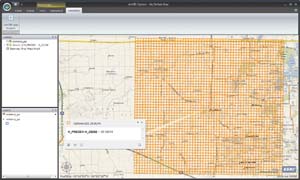
Figure 3: An attribute calculation in uWATER determining the level of the water table at two times (i.e., groundwater drawdown)
The Attribute Calculation tab allows users to add a shapefile from the local computer to the ArcGIS Explorer display and perform simple attribute calculations using the shapefile's attribute table. The program permits addition, subtraction, multiplication, and division of any two numeric attributes. Calculation results are added to the ArcGIS Explorer table of contents and map display as notes, an ArcGIS Explorer data format denoted by a file folder symbol in the table of contents. All results of uWATER procedures are stored as notes and grouped in folders. The notes folder contains a single note for each feature in the shapefile. Each note generated by an attribute calculation is assigned a name that begins with the string CalNote. The remainder of the name is specified by the user and may include the FID (the feature ID that exists for every shapefile), the calculation result, or both. Notes have the same spatial domain as the original shapefile.
The Complex Query tab allows combined spatial and attribute queries of user-imported shapefiles. The shapefile name is entered in a window in the Add Shapefile for Query box as shown in Figure 2. An additional shapefile and notes can be used as criteria. If additional shapefile data will be included in the query, the Adding external shapefile radio button is selected. If notes calculated during the same ArcGIS Explorer session will be employed in the query, select the Using the previous calculated Notes radio button. Selection of either radio button activates a group box that allows the user to specify a range of data using minimum and maximum values from the chosen data source.
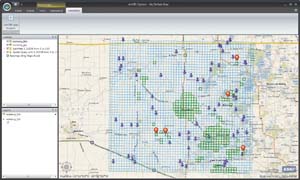
Figure 4: A complex query in uWATER intersects query points for fish sample sites with polygons representing groundwater drawdown greater than 5 feet
The user selects the desired spatial relationship for the spatial query from the options in Table 1. Clicking the Identify features button executes the query. Two folders of notes are created. The identified feature notes folder contains a note for each feature identified using the specified minimum and maximum values. Each note is (by default) assigned a name beginning with the string IdfNote (if the features are stored as notes) or EXTNote (if the features are stored in a shapefile). The spatial query notes folder contains one note for each feature identified through the spatial query. By default, the names assigned to these notes begin with the string SQNote.
A Real-World Application
Data from a real-world water resources management project in McHenry County, Illinois, is included with the uWATER application and can be used to demonstrate uWATER functions. The water supplies for McHenry County, located in northeast Illinois, are derived entirely from groundwater. Consequently, groundwater is a vital resource for residents and the county's economy (Meyer 1998). With rapid population growth, groundwater withdrawals are expected to increase and may result in the degradation of the natural environment. Groundwater is found within underground aquifers in the saturated zone where water fills all the pore spaces in the subsurface materials. The water table (groundwater level) is located at the top of the saturated zone.
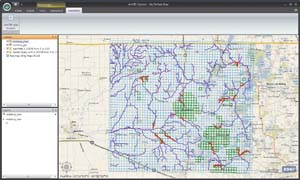
Figure 5: A complex query in uWATER intersecting query lines for rivers with polygons representing groundwater drawdown greater than 5 feet
The Illinois State Water Survey used a groundwater model (Meyer et al., in preparation) to simulate the water table under different future climate and water use scenarios. The results are stored in shapefile format and displayed as model cells covering the entire spatial domain of McHenry County. The attribute table contains the elevation (in feet above mean sea level) of the groundwater level for each cell under different pumping scenarios. These are used as the input for uWATER.
First, uWATER can be used to compute the groundwater drawdown in each cell. When groundwater is withdrawn from a well, a cone of depression is formed. In this example, groundwater drawdown means the difference in a water table between natural (i.e., predevelopment) conditions and the water table after a cone of depression develops at the same location.
Groundwater drawdown might cause several environmental problems. Drawdown may dry nearby wells and result in an insufficient water supply; it may also decrease the groundwater discharge to rivers or wetlands. This could cause the decline of base flow or stream stage, resulting in serious ecological issues such as water quality degradation and fish habitat losses. Therefore, excessive groundwater drawdown should be evaluated in the areas where water supplies are heavily dependent on groundwater.
The attribute calculation function in uWATER can easily compute drawdown using the water table from two different periods. For example, if one wishes to know drawdown in 2025 compared with predevelopment conditions, uWATER can compute the drawdown and show the results as notes in ArcGIS Explorer (shown in Figure 3).
If one wishes to evaluate the impact of groundwater drawdown on other natural resources, a uWATER complex query can be used. Natural resources, such as fish (represented by collection sites), rivers, and wetlands, may be depicted in three different spatial formats: points, lines, and polygons. An analyst may wish to identify natural resources that intersect cells that will have drawdowns greater than 5 feet in 2025.
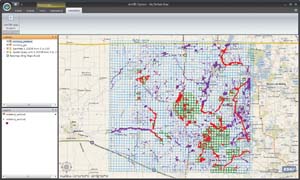
Figure 6: A complex query in uWATER intersecting polygons for wetlands with polygons representing groundwater drawdown greater than 5 feet
uWATER first identifies the cells with drawdown greater than 5 feet using the groundwater modeling result shapefile. Figures 4 to 6 show the results of these queries. The blue cell is the groundwater modeling result shapefile, and the green cells are the cells with drawdown greater than 5 feet calculated by uWATER. Overlapped with the basemap underlying the groundwater modeling result, areas with larger drawdown values (green cells) are all located near large municipalities such as Crystal Lake, Woodstock, and Algonquin. After identification of these cells, uWATER conducts a spatial query on the fish sample sites (purple points in Figure 4), rivers (purple lines in Figure 5), and wetlands (purple polygons in Figure 6). Various natural resource features that might be affected by groundwater withdrawal can be easily identified (red-colored features shown in Figures 4, 5, and 6) based on the special distribution of green cells. In these examples, decision makers could choose to focus on these red-colored features.
Conclusion
With this free GIS-based DSS, nonspecialists can consider the results of technical modeling, along with societal values, when making decisions that affect sustainable resource management. The uWATER package (main program, test data, and manual) can be downloaded for free at isws.illinois.edu/gws/sware/uwater/. The download package includes the plug-in program, user's manual, and example files.
For more information, contact Yi-Chen E. Yang (yang24@illinois.edu) and Yu-Feng F. Lin (yflin@illinois.edu), Illinois State Water Survey, Esri-GIS Development Center, Institute of Natural Resource Sustainability, University of Illinois at Urbana-Champaign, 2204 Griffith Drive, Champaign, Illinois 61820.
Acknowledgments
This project is sponsored by the County of McHenry, Illinois, USA. Fish data was provided by Mike Retzer and Chris Meyer of the Illinois Natural History Survey. The authors also thank Scott C. Meyer, Jun Wan, and other beta testers for improving this software package.
About the Authors
Yi-Chen Ethan Yang was awarded an Esri-GIS Development Center Scholarship at the University of Illinois in March 2010. Since receiving his doctorate in civil and environmental engineering from the University of Illinois, he has been employed at the Illinois State Water Survey and as an instructor at the Esri-GIS Development Center, which are both part of the Institute of Natural Resource Sustainability at the University of Illinois. His research interests are coupled natural-human systems, agent-based modeling, and hydroecology.
Yu-Feng Forrest Lin is the founding director of the Esri-GIS Development Center at the University of Illinois and a hydrogeologist at the Illinois State Water Survey. His current research involves environmental impact associated with geologic carbon (CO2) sequestration, GIS applications in natural resource management, and water resources investigations in the Great Lakes region.
References
Ahamed, T., M. I. N. Khan, T. Takigawa, M. Koike, F. Tasnim, and J. M. Q. Zaman. 2009. "Resource management for sustainable development: A community- and GIS-based approach." Environment Development and Sustainability 11:933-954.
Committee on Models in the Regulatory Decision Process (CMRDP). 2007. "Models in Environmental Regulatory Decision Making." The Board on Environmental Studies and Toxicology, the Division on Earth Life Studies, National Research Council of the National Academies. Washington, D.C.: National Academies Press.
Meyer, S. C. 1998. "Ground-Water Studies for Environmental Planning, McHenry County, Illinois." Illinois State Water Survey Contract Report 630, Champaign, IL.
Meyer, S. C., H. A. Wehrmann, H. V. Knapp, Y.-F. Lin, F. E. Glatfelter, D. Winstanley, J. R. Angel, J. F. Thomason, and D. A. Injerd. (In preparation). "Northeastern Illinois Water Supply Planning Investigations: Opportunities and Challenges of Meeting Water Demand in Northeastern Illinois." Illinois State Water Survey Contract Report.
Ramsey, K. 2009. "GIS, modeling, and politics: On the tensions of collaborative decision support." Journal of Environmental Management 90:1972-1980.
Shrier, C., D. Fontane, and L. Garcia. 2008. "Spatial knowledge-based decision analysis system for pond site assessment." Journal of Water Resources Planning and Management 134(1):14-23.
| Method | Description |
|---|---|
|
Contains |
Searches for occurrences where the input geometry completely contains any of the geometries stored in the table. Valid for all shape type combinations. |
|
Crosses |
Searches for occurrences where the input geometry intersects any of the geometries stored in the table but only shares points in common, at least one of which is not an endpoint. A polyline and a polygon cross if they share a polyline in common on the interior of the polygon that is not equivalent to the entire polyline. Valid for polyline/polyline, polyline/polygon, and polygon/polyline shape type combinations. |
|
Intersects |
Searches for any type of spatial relationship between the input geometry and the geometries stored in the table. Valid for all shape type combinations. |
|
Overlaps |
Searches for occurrences where the input geometry intersects any of the geometries stored in the table but also where the region of their intersection is of the same dimension as the geometries involved and is not equivalent to either of the geometries (i.e., the shapes cannot be completely on top of each other). Applies to polygon/polygon, polyline/polyline, and multipoint/multipoint shape type combinations. |
|
Touches |
Searches for occurrences where the input geometry shares a common boundary with any of the geometries stored in the table but also where the intersection of the interiors of the searched shapes is empty. In the point/polyline case, the point may touch an endpoint only of the line. Applies to all combinations except point/point. |
|
Within |
Searches for occurrences where the input geometry is completely within any of the geometries stored in the table. Valid for all shape type combinations. |
Table 1: Spatial query methods in uWATER (adapted from ArcGIS Explorer SDK Developer Help)
